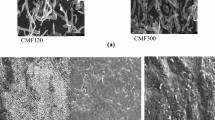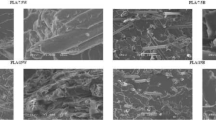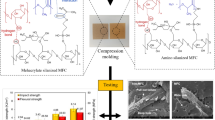Abstract
Biocomposites were prepared by solvent casting from poly(vinyl) alcohol and mechanically microfibrillated (MFC) birch pulp. Preparations varied in concentration of polymer solution, mixing time of cellulose/PVA dispersion and were either degassed or not. In addition, specimens were tested in different levels of relative humidity at a constant temperature. The results show that the preparation method has a significant influence on mechanical properties. It was observed that aggregation of microfibrills was easier at lower concentrations of polymer solution leading to inferior properties of composites. Degassing provided increase in Young’s modulus and tensile strength at MFC loads below 10% (w/w). However, there was no significant change in composites density. Longer mixing time significantly deteriorated mechanical properties of biocomposites. The relative humidity proved to be very important factor. The properties of composites conditioned at 45% RH showed higher strength and stiffness properties than conditioned at 55 %RH. The experimental data were in a good agreement with percolation model.














Similar content being viewed by others
Notes
Elemental chlorine free—bleaching without chlorine gas or hypochlorite, but chlorine dioxide (ClO2) is used in one or more stages.
References
Lars B (2005) In: Amar MK, Manjusri M, Drzal LT (eds) Natural fibers, biopolymers and biocomposites. Taylor & Francis, Routledge
William HBrown (ed) (1988) Introduction to organic chemistry, 4th edn. Brooks/Cole publishing company, California
Azizi SM, Said A, Alloin F, Dufresne A (2005) Biomacromolecules 6:612
Hubbe MA, Rojas OJ, Lucia LA et al (2008) BioResources 3:929
Dufresne A (2008) Can J Chem 86:484
Eichhorn SJ, Dufresne A, Aranguren M et al (2010) J Mater Sci 45:1. doi:ESI-2010-007
Orts WJ, Shey J, Imam SH et al (2005) J Environ Polym Degr 13:301
Roohani M, Habibi Y, Belgacem NM et al (2008) Eur Polym J 44:2489
Gopalan NK, Dufresne A (2003) Biomacromolecules 4:657
Samir M, Alloin F, Dufresne A (2005) Biomacromolecules 6:612
Garcia DR, Thielemans W, Dufresne A (2006) Cellulose 13:261
Nakagaito AN, Yano H (2004) Appl Phys A 78:547
Zimmermann T, Pöhler E, Geiger T (2004) Adv Eng Mater 6:754
Nakagaito AN, Yano H (2005) Appl Phys A 80:155
Chakraborty A, Sain M, Kortschot M (2006) Holzforschung 60:53
Lu J, Wang T, Drzal LT (2008) Compos A 39:738
Cheng Q, Wang S, Rials T et al (2007) Cellulose 14:593
Cheng Q, Wang S, Rials TG (2009) Compos A 40:218
Tang C, Liu H (2008) Compos A 39:1638
Billmeyer FWJ (1984) Textbook of polymer science. Wiley, Singapore
Food and Agriculture Organization of the United Nations (FAO) and the World Health Organization (WHO) (2004) Polyvinyl alcohol. ftp://ftp.fao.org/es/esn/jecfa/cta/CTA_61_PVA.pdf. Accessed 27 Nov 2010
Li H (2000) Macromolecules 33:465
Cinelli P, Lawton JW, Gordon SH et al (2003) Macromoleculars no. 197:115
Said AS, Alloin F, Paillet M et al (2004) Macromolecules 37:4313
Nakagaito A, Yano H (2008) Cellulose 15:555
Lu J, Askeland P, Drzal LT (2008) Polymer 49:1285
Sakurada I, Nukushina Y, Ito T (1962) J Polym Sci 57:651
Cheng Q, Wang S, Harper DP (2009) Compos A 40:583
Cox HL (1952) Br J Appl Phys 3:72
Davies WEA (1971) J Phys D 4:1176
Davies WEA (1971) J Phys 4:318
Hill R (1963) J Mech Phys Solids 11:357
Hill R (1964) J Mech Phys Solids 12:213
Affdl JCH, Kardos JL (1976) Polym Eng Sci 16:344
Allen G, Bowden MJ, Todd SM et al (1974) Polymer 15:28
Favier V, Chanzy H, Cavaille JY (1995) Macromolecules 28:6365
Favier V, Cavaille JY, Canova GR et al (1997) Polym Eng Sci 37:1732
Chazeau L, Cavaillé JY, Canova G et al (1999) J Appl Polym Sci 71:1797
Ouali N, Cavaille JY, Perez J (1991) Plast Rubber Compos Process Appl 16:55
Aharony A, Stauffer D (1994) Introduction to percolation theory, 2nd edn. Taylor & Francis, UK
Young RJ, Lovell PA (1991) Introduction to polymers, 2nd edn. Chapman & Hall, Cambridge
Taghizadeh MT, Mehrdad A (2003) Ultrason Sonochem 10:309
Alexy P, Lacík I, Šimková B et al (2004) Polym Degrad Stab 85:823
Acknowledgements
Authors would like to thank the Academy of Finland (decision number 12706) for financial support and DuPont Finland for providing poly(vinyl) alcohol. Thanks to Alexander Perros for help with SEM imaging.
Author information
Authors and Affiliations
Corresponding author
Rights and permissions
About this article
Cite this article
Bulota, M., Jääskeläinen, A.S., Paltakari, J. et al. Properties of biocomposites: influence of preparation method, testing environment and a comparison with theoretical models. J Mater Sci 46, 3387–3398 (2011). https://doi.org/10.1007/s10853-010-5227-4
Received:
Accepted:
Published:
Issue Date:
DOI: https://doi.org/10.1007/s10853-010-5227-4




